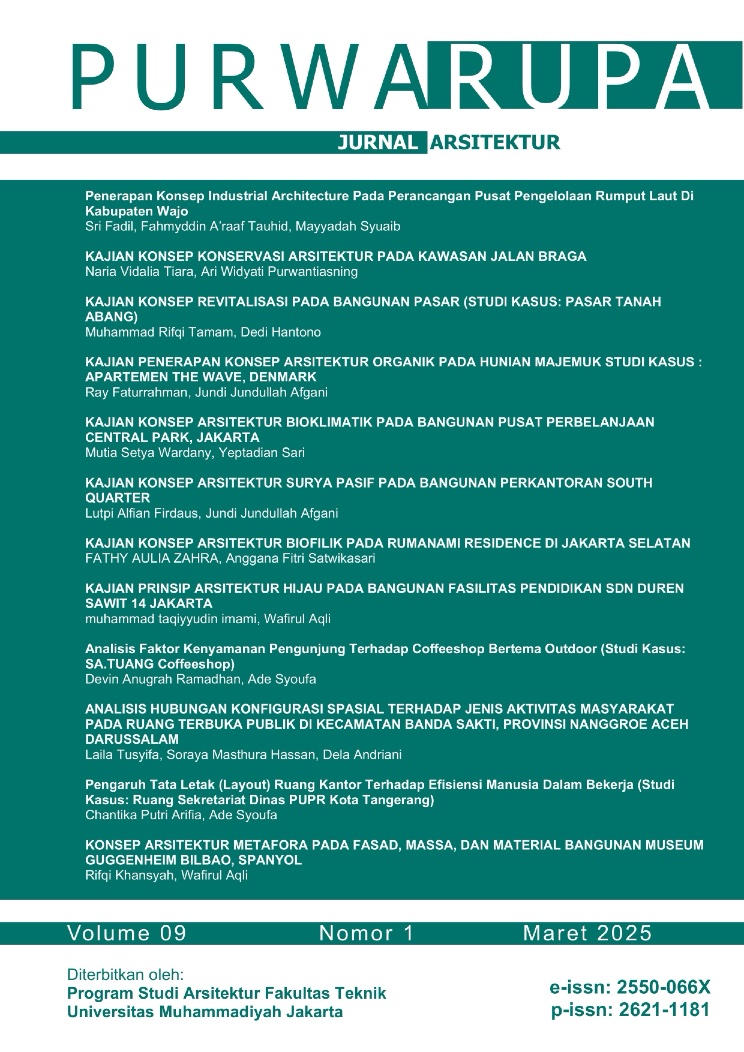KAJIAN KONSEP ARSITEKTUR BIOFILIK PADA RUMANAMI RESIDENCE DI JAKARTA SELATAN
Abstract
Jakarta adalah ibu kota, pusat kegiatan, dan kota yang berkembang pesat dan merupakan salah satu kota dengan laju pertumbuhan penduduk tertinggi.Tingkat pertumbuhan yang tinggi mengakibatkan kebutuhan perumahan tidak terpenuhi, sehingga menyebabkan terbentuknya permukiman kumuh dan berdampak negatif terhadap kesehatan fisik dan mental masyarakat yang tinggal di permukiman kumuh. Perlu nya konsep Arsitektur Biofilik yang merupakan sebuah konsep dengan mengedepankan hubungan positif antara manusia dan alam yang bertujuan untuk meningkatkan kesehatan fisik dan mental kehidupan manusia dengan menerapkan bahan dan bentuk alami ke dalam desain. Penlitian yang berjudul “KAJIAN KONSEP ARSITEKTUR BIOFILIK PADA RUMANAMI RESIDENCE DI JAKARTA SELATAN” ini dilakukan pada bangunan hunian majemuk yaitu Rumanami residence dengan menggunakan metode analisis deskriptif untuk mendapatkan pemahaman tentang aplikasi konsep arsitektur biofilik pada hunian majemuk. Hasil yang di dapat pada penelitian ini bahwa konsep arsitektur biofilik dapat diterapkan dengan menghadirkan tanaman didalam dan luar bangunan, menggunakan material alami, lukisan bermotif alam, pola denah yang berulang, sirkulasi berliku dalam bangunan, penggunaan atap skylight serta ruang tempat berllindung seperti kamar tidur. Kata Kunci: Arsitektur, Biofilik, Hunian majemuk ABSTRACT. Jakarta is the capital city, center of activity and a city that is developing rapidly and is one of the cities with the highest population growth rate. High growth rates result in housing needs not being met, thus causing the formation of slums and having a negative impact on the physical and mental health of the people who live there. in slums. There is a need for the concept of Biophilic Architecture, which is a concept that prioritizes a positive relationship between humans and nature which aims to improve the physical and mental health of human life by applying natural materials and forms into the design. The research entitled "STUDY OF THE CONCEPT OF BIOPHILIC ARCHITECTURE IN RUMANAMI RESIDENCE IN SELATAN JAKARTA" was carried out on a compound residential building, namely Rumanami residence, using descriptive analysis methods to gain an understanding of the application of the concept of biophilic architecture in compound residences. The results obtained from this research are that the concept of biophilic architecture can be applied by presenting plants inside and outside buildings, using natural materials, paintings with natural motifs, repeating floor plans, winding circulation in buildings, using roof skylights and sheltered spaces such as bedrooms. Keywords: Architecture, Biophilic, Compound housingDownloads
Published
How to Cite
Issue
Section
License
COPYRIGHT POLICY
The author(s) of an article published in the Jurnal Teknologi retains ownership of the intellectual property rights in work (s).
PUBLISHING RIGHTS
The author(s) of an article published in the Jurnal Teknologi have unrestricted publication rights. The authors give the Jurnal Teknologi the right to publish the article and designate the Faculty of Engineering Universitas Muhammadiyah Jakarta Publishing as the original publisher of the article.
LICENSING POLICY
Journal of Mechanical Engineering and Sciences is an open-access journal that follows the Creative Commons Non-Commercial 4.0 International License (CC BY-NC 4.0), which states that:

Under this license, the reusers must give appropriate credit, provide a link to the license, and indicate if changes were made. Users may do so in any reasonable manner, but not in any way that suggests the licensor endorses users or their use.
Please take the time to read the whole license agreement (https://creativecommons.org/licenses/by-nc/4.0/). As long as reusers follow the license conditions, the owner cannot withdraw these freedoms. The following components are included under this license:
 Attribution: Users must provide appropriate attribution, including a link to the license, and indicate whether or not they made any modifications. Users are free to do so reasonably, but not in a manner that indicates the licensee approves of their usage.
Attribution: Users must provide appropriate attribution, including a link to the license, and indicate whether or not they made any modifications. Users are free to do so reasonably, but not in a manner that indicates the licensee approves of their usage.
 NonCommercial: Users may not use the material for commercial purposes.
NonCommercial: Users may not use the material for commercial purposes.

